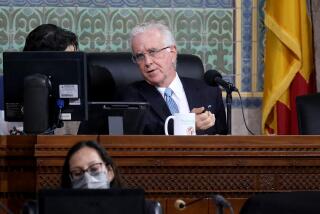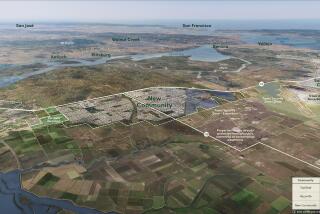Wilson Attacks Problems Tied to Growth
SACRAMENTO — Fulfilling an early campaign promise, Gov. Pete Wilson will launch an attack on problems created by California’s explosive growth when his new Growth Management Council begins taking testimony today in hearings around the state.
Today’s hearing in Riverside is the first of 13 that will be held during the next two months in preparation for a state growth management policy that Wilson intends to announce next year.
“The issue is cresting,” said Jane Pisano, president of the Los Angeles 2000 Partnership, which has called for more regional government to manage growth. “If nothing happens next year, I think it will be a long time before anything does happen.”
The plan that emerges, combined with similar efforts in the Legislature, will have a major impact on California, whether it involves new regional governments that have the power to overrule cities and counties or a more moderate approach favored by Wilson that requires a high level of cooperation among government agencies that often are at odds with one another.
Although local opinion will be sought extensively, Richard Sybert, Wilson’s director of policy and research and chairman of the 15-member council, made it clear that he and Wilson believe that the state must play a key role in solving growth-related problems such as traffic congestion, dirty air, lack of affordable housing and water shortages.
“Some level of growth is going to be inevitable,” Sybert said. “But we’re going to shape it and manage it for the state’s good.” The governor’s plan, whatever it turns out to be, will join a rather long list of growth management proposals that have emerged in the last year or so.
The Legislature is considering four major bills on the subject, although their authors are holding them in what one legislative aide called a “park and lock” position, waiting to see what is in the Wilson plan.
Other studies by a Los Angeles group called LA 2000 and a similar group in the San Francisco Bay Area named Bay Vision 2020 have produced recommendations for strong regional government structures. Meanwhile, the Consensus Project, a group of about 90 people representing 32 different organizations from businesses to minority groups, has been meeting for the last six months and has reached, if not consensus, at least widespread agreement on what steps need to be taken. One or two of its participating groups have suggested that methods of limiting California’s population at least be studied--a proposal that seems so far to have drawn little support.
“We’re not going to be sending out sterilization squads and we’re not going to be posting armed guards at the borders,” Sybert said.
California’s population has increased by 6.1 million in the last 10 years, to a present total of more than 31 million.
Forty-five percent of the increase was natural--that is, more Californians were born than died. Migration from other countries accounted for 37%, migration from other states the remaining 18%, according to the state Department of Finance’s population unit.
Growth, proceeding at breakneck speed, has brought increased traffic congestion, air pollution, suburban sprawl, higher housing costs, greater family stress and a host of other problems, the Senate Office of Research pointed out in a recent report.
If growth is inevitable, the question is how to manage it in a sensible way.
Most of the studies completed to date agree on these points:
* Statewide and regional planning are weak.
* Turf wars and overlapping jurisdictions sap what strength there is in regional and statewide planning efforts.
* More money must be found to repair the state’s infrastructure (roads, bridges, schools, hospitals, libraries, sewage plants and so on) and to prepare for future growth.
* Rapid growth and poor planning have taken a heavier toll among poor people, especially racial minorities, than among the middle and upper classes.
Three of the four major bills being considered by the Legislature--introduced by Assembly Speaker Willie Brown (D-San Francisco), Assemblyman Sam Farr (D-Carmel) and Sen. Robert Presley (D-Riverside)--seek to solve these problems by setting up strong regional planning agencies or by improving statewide coordination of local planning efforts.
The Brown bill, for example, would establish seven regional agencies in the state’s largest urban areas. They would replace the current air quality control districts, water quality control boards and other regional groups, in the hope of avoiding the interagency conflicts that often cripple planning efforts.
The fourth bill, sponsored by Sen. Marion Bergeson (R-Newport Beach), permits local officials to create “regional fiscal authorities” that could pay for needed infrastructure through general obligation bonds, revenue bonds, impact fees, benefit assessments or special taxes.
Bergeson’s bill would not require local officials to participate, while the other three have at least some mandatory elements.
The Los Angeles 2000 Partnership, formed to implement the recommendations of the LA 2000 plan, has recommended that all the planning functions of the South Coast Air Quality Management District, the Metropolitan Water District, the California Transportation Commission and several other bodies be combined into a new Southern California Regional Council.
“There has been a tremendous growth of single-purpose agencies in the Los Angeles area,” said Pisano, who is leaving the presidency of the Los Angeles 2000 Partnership to become dean of the School of Public Administration at USC. “We’re spending a fortune on this stuff but it’s too fragmented and we’re not getting our money’s worth.”
As the discussions continue, the concept of “urban boundaries” or “urban growth lines” is getting a lot of attention.
The basic idea is that development is encouraged within the urban boundaries, discouraged outside them.
Proponents claim that urban boundaries lead to better use of existing services, conserve energy and improve air quality by cutting down on commuting distances, save open space and make construction of affordable housing more feasible, among other benefits.
But many developers do not like the idea.
Greg McWilliams, vice president of Kaufman and Broad, a Los Angeles-based home building company and a participant in the Consensus Project, said setting aside certain areas for development while others are exempted drives up land prices and makes housing more expensive. As members of Wilson’s new council trek around the state, one question they will seek to answer is whether growth management should be voluntary or mandatory.
“We believe a voluntary approach will work,” Sybert said. “If it’s in people’s interests, they will do it voluntarily.”
But Carol Whiteside, former mayor of Modesto and an assistant secretary in the state Resources Agency, was skeptical. “Everybody wants voluntary to work,” she said, “but whether that’s possible in the long run remains to be seen.”
Another question is how to pay for the schools, roads, bridges and other infrastructure that California’s swelling population will require.
“This is already a high-tax jurisdiction,” Sybert said. “We don’t want to drive business out of the state with even higher taxes. I think it’s a case of convincing the middle class, which pays most of the taxes, that they’ll get more bang for the buck,” so they will be willing to pay for growth management, Sybert added.
Sybert said he has discussed growth issues with Wilson on many occasions and is convinced that the governor is determined to get a handle on the problem.
“He knows growth is inevitable,” he said, “but he doesn’t think we have to just sit and let it wash over us.”
More to Read
Get the L.A. Times Politics newsletter
Deeply reported insights into legislation, politics and policy from Sacramento, Washington and beyond. In your inbox three times per week.
You may occasionally receive promotional content from the Los Angeles Times.










